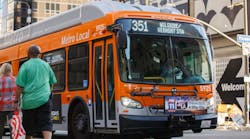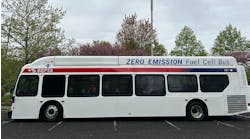The California Transportation Commission (CTC) has awarded more than $2.2 billion to 181 projects across California that will reduce congestion and greenhouse gas emissions, increase the competitiveness of California’s freight network, enhance safety for motorists, bicyclists and pedestrians and benefit disadvantaged and underserved communities.
The CTC awarded projects in the third funding cycle of the competitive grant programs established by Senate Bill (SB)-1, the Road Repair and Accountability Act of 2017, and regionally prioritized projects in the sixth funding cycle of the Active Transportation Program. The investments will help fund projects with a total cost of $8.4 billion, leveraging nearly four dollars from local, regional and federal fund sources for every dollar invested.
“In awarding these projects, the Commission is delivering transformative transportation investments that will enhance safety and mobility in communities across California while creating thousands of good-paying jobs,” said CTC Chair Lee Ann Eager. “These investments will help us fight climate change by reducing single-occupancy vehicle trips, they will keep our transportation system economically competitive and they will make disadvantaged and underserved communities safer by making it easier to bike and walk.”
“The billions of dollars we are approving go far beyond roads and highways,” said CTC Vice Chair Carl Guardino. “These programs include significant investments in transit, zero-emission freight and bicycling and pedestrian improvements and demonstrate the Commission’s commitment to being a good steward of Californians’ Senate Bill-1 dollars.”
The 2022 SB-1 programs include $1.7 billion over two fiscal years for three competitive grant programs:
- The Solutions for Congested Corridors Program
- The Trade Corridor Enhancement Program
- The Local Partnership Competitive Program
The recommended projects reduce greenhouse gas emissions, improve air quality, foster economic growth and make California’s transportation system more equitable by delivering new mobility options to underserved communities.
For the first time in the SB-1 programs, the CTC’s Interagency Equity Advisory Committee, which was recently created in partnership with the California State Transportation Agency and the California Department of Transportation, participated in the evaluation of projects, helping to ensure funding decisions provide more equitable outcomes. Cycle 3 is also the first program cycle to incorporate all near-term strategies identified in the state’s Climate Action Plan for transportation infrastructure, with an updated project selection process that supports the state’s climate, public health, safety, equity and economic goals.
The 2023 Active Transportation Program includes $1.7 billion over four years split into three components:
- The Statewide Component ($853.5 million)
- The Small Urban & Rural Component ($170.7 million)
- The Metropolitan Planning Organization Component, which is divided among the 10 largest metropolitan areas in the state based on population ($682.8 million).
The program funds projects that increase the share of walking and biking trips, increase safety and mobility for nonmotorized users, help regional agencies achieve greenhouse gas reduction goals, enhance public health and ensure disadvantaged communities fully share in program benefits. The CTC awarded the final $539 million for this funding cycle to projects selected by nine of the largest metropolitan planning organizations in the state. The CTC previously awarded funds in the Statewide and Small Urban & Rural Components of the program in December 2022 and in the Metropolitan Planning Organization Component for the Metropolitan Transportation Commission region in May of 2023.
Funding for the 2022 SB-1 programs comes from fuel taxes and the SB-1 Transportation Improvement Fee, with some funding for the Trade Corridor Enhancement Program coming from federal formula funding. Funding for the 2023 Active Transportation Program comes from federal formula funding, fuel taxes and a one-time augmentation from the state’s general fund.
The full lists of projects included in each program can be found on CTC’s website.
Highlights from each program include:
Solutions for Congested Corridors Program
- $507.4 million for 10 projects, with total project costs of $3.2 billion.
- Heavy focus on multimodal solutions to increase bus service, walking and biking.
- Projects informed by grassroots, nonprofit-led community engagement efforts, which help ensure equitable, dynamic, community-oriented transportation networks.
- Emphasis on climate adaptive and resilient design to make facilities less vulnerable to extreme weather events.
- Includes new zero-emission transit infrastructure and measures to reduce vehicle miles traveled.
- Invests in networks of safe and accessible bicycle and pedestrian facilities and infrastructure.
- Constructs wildlife crossings to protect animals and motorists in rural areas.
Trade Corridor Enhancement Program
- $1.081 billion for 26 projects, with total project costs of $3.8 billion.
- Builds highway and operational improvements that support a safer, more efficient and more environmentally friendly flow of goods.
- For the first time in the program, includes more than $100 million for zero-emission freight infrastructure to build refueling and recharging facilities along key freight corridors.
- Constructs a new international border crossing and new commercial vehicle enforcement facility, enabling the reliable and safe movement of essential goods while creating a state-of-the-art screening process to reduce congestion and greatly enhance security at the border.
- Funds more than $150 million in vital rail infrastructure and new rail track, including at seaports,
- ensuring that goods have a myriad of means to be safely transported through the state.
- Improves operational efficiency and travel time, enhances the safe movement of goods and improves air quality by increasing truck throughput and rail volume.
Local Partnership Competitive Program
- $142.4 million for 11 projects, with total project costs of $610.3 million. Funding in this program rewards agencies that have elected to tax or impose fees within their regions.
- Large emphasis on transit improvements that will provide new and enhanced transit stations, build electric bus charging infrastructure and expand the state’s transit network.
- Promotes safe and efficient traffic operations by reconstructing an interchange and overcrossing, adding a safer rail crossing, implementing modernized traffic management systems and building complete streets elements that create a safer more welcoming environment for travelers.
- Delivers active transportation improvements across multiple projects, building miles of new bike lanes and sidewalks to create safer streets.
Active Transportation Program – Metropolitan Planning Organization Component
- $539 million for 134 projects, with total project costs of $937 million in nine out of the 10 largest metropolitan areas of the state.
- Awards 92 percent of funding for projects that benefit disadvantaged communities and 54 percent of funding for Safe-Routes-to-School projects.
- Includes 120 miles of new bikeways, 60 miles of new sidewalks, intersection timing improvements, high-visibility crosswalks, lighting improvements, Americans with Disabilities Act-compliant curb ramps and bus boarding islands.
- Provides healthy mobility and connectivity options to make getting around communities safer.
- Increases proportion of trips completed walking or biking and reduces vehicle miles traveled and greenhouse gas emissions.
- Allows more Californians to access jobs, schools, community resources, transit and critical services without requiring the use of a car.



